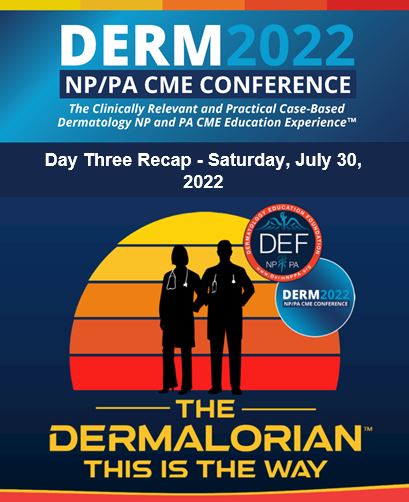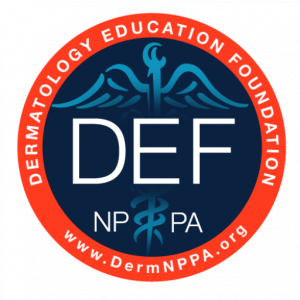

Highlights from Today’s CME Presentations:
Rosacea Therapeutic Updates with Julie Harper
Dr. Julie Harper began her rosacea update with discussion about the classification and pathophysiology of rosacea. We no longer recommend subtype labeling. Rather, Dr. Harper recommends “treat(ing) everything you see!” Multiple/combination therapies often result in improved outcomes for patients. Newer treatment agents include Zilxi (minocycline ) foam, Epsolay (benzoyl peroxide) 5% cream, and systemic oral Seysara (serecycline). Remember to discuss triggers with each patient and encourage avoidance/minimizing exposure where possible. Dr. Harper presented a treatment algorithm beginning with general skincare including one of the following topical therapies: alpha-adrenergics (Rhofade), azelaic acid (Finacea, Azelex), Ivermectin (Soolantra) or Metronidazole. Some patients may also require oral agents such as beta blockers, doxycycline, and/or isotretinoin. Electrodesiccation, intense pulsed light, vascular laser, and physical modalities including surgery/ablation may also be required. Despite improvement in skin lesion count and texture, patients may still be seeing red! Dr. Harper recommends use of Rhofade (oxymetazoline) to give patients improvement with flushing and redness.
Acne Vulgaris Treatment Updates with Hilary Baldwin
When you attend the Dermatology Educational Resource Meeting for NP/PA’s, you get to see experts talk about what’s new and what’s coming for various dermatologic diseases! This was true today when Dr. Hillary Baldwin said, “What’s new in acne vulgaris is new chemical entities, new formulations and vehicles, and treatment of truncal acne!” Dr. Baldwin reminded us of the pathophysiology of acne as well as the current treatment guidelines. She insisted, combination therapy is best. Did you know benzoyl peroxide is the most effective antimicrobial agent in the treatment of acne? Oral contraceptives and anti-androgens such as Aldactone (spironolactone), cyproterone acetate, and flutamide are often used in the treatment of hormonal acne. Isotretinoin is a mainstay of treatment. New therapies to treat acne vulgaris include Amzeeq (minocycline) foam 4%, Twyneo (microencapsulated benzoyl peroxide 3%/tretinoin 0.1%), and Winlevi (clascoterone 1% cream). We have several new agents in the treatment pipeline including a combination clindamycin 1.2%/benzoyl peroxide 3.1%/adapalene 0.15% agent, as well as micronized isotretinoin. Stay tuned for more talks about what’s new!
To bait us with what’s to come, Dr. Baldwin ended with a discussion of what has her attention in acne vulgaris treatment. Seysara (serecycline) and MinoLira (minocycline) are unique, systemic treatments for acne. Three agents are in phase III clinical trials for truncal acne: Aklief (trifarotene), Winlevi (clascoterone), and Seysara (serecycline). Arazlo (tazarotene) 0.45% lotion has a dedicated truncal acne study with favorable results.
Acne and Diet with Adam Friedman
Dr. Adam Friedman began his talk today entitled, “Diet and Acne” by reminding us acne is a “disease of Western Civilization.” It’s true. While 95% of Americans have dealt with some form of acne in their lifetime, there are entire populations of people in South America who have never seen acne. There are many hypotheses about why this is true ranging from cow’s milk consumption to diets rich in carbohydrates and high calorie intake. If ever there was an area lacking in nutritional guidance, it’s acne.
Dr. Friedman discussed the pathophysiology of acne and then current best-practice treatment guidelines. He shared a simple algorithm considering the 4 causes of acne and linked those causes to nutritional recommendations to help reduce acne “naturally” with diet and supplements. Further, he discussed the role of cow’s milk on acne, insulin resistance, and high BMI. He presented a low-glycemic diet in detail for consideration given patients with high glycemic index have more acne than control patients in multiple research studies. In case your patients want to know, in an article published in 1969 in the Journal of the American Medical Association, chocolate consumption did not affect the output of sebum. Phew! I’d say that’s great news for chocolate lovers! So, he summarized the little evidence of diet and nutrition in acne suggests a low glycemic index diet is helpful, milk and whey products may increase acne count, and omega-3 fatty acids and y-linoleic acid use may reduce acne lesion counts. Chocolate lovers everywhere thank you, Dr. Friedman!
Application of Artificial Intelligence in the Diagnosis of Skin Cancer with Steven Wang
It was “all things science” in Dr. Wang’s talk entitled “AI in Dermatology” today during his break-out session. He discussed the application of scientific tools such as dermoscopy in improving diagnostic outcomes. Serial body imaging can help providers identify new, suspicious, and changing skin lesions using statistical analysis and comparison tools. Reflectance confocal microscopy is expensive and not readily available in your pocket like a dermatoscope However, it can add to and/or confirm your diagnosis in some cases (nMsc). While AI is not new, it is new in the field of dermatology. One of the first published cases for AI in dermatology was documented in the British Journal of Dermatology in 2004 and presented a digital image analysis of 837 melanocytic nevi creating a digital video-microscopy tool to aid in the diagnosis of malignant melanoma. In 2017, Nature published an article entitled, “’Automated dermatologist’ detects skin cancer with expert accuracy.” Now, numerous partnerships exist to collect images (mostly malignant melanoma) for scientific study. In a 2019 article published in Lancet Oncology, machine-learning classifiers outperformed human experts in the diagnosis of melanocytic lesions. Vectra Whole Body 3D Capture System is a tool used to capture all exposed skin in a file within 3 milliseconds. The tool produces images for review, can be downloaded into a patient’s chart, and can aid in identifying concerning skin lesions which should be considered for biopsy. This “Human-computer collaboration” seems to be the wave of the future per Dr. Wang. Dr. Wang ended his discussed with a simple reminder to connect with patients. Remember we’re human and our patients come see us to communicate, be heard and valued.
Trials and Tribulations: A Dive into Clinical Trials in Dermatology with April Armstrong
Dr. April Armstrong gave a presentation about clinical trials in the dermatology setting. She began with a brief review of scientific inquiry. She discussed the clinical trial process: from preclinical questions to FDA-approval. She discussed the role of the principal investigator (PI) in a clinical trial, and briefly laid out the clinical research staff required to complete a clinical study. Dr. Armstrong reviewed protocol design including inclusion/exclusion criteria, challenges, patient population, site capabilities, logistics, budget, schedule, and even serious event recording. She gave us a deep dive into what it takes to create and perform research within our field.
Skin of Color Highlights from Dermatology Literature with Ted Rosen
Dr. Rosen presented today on skin of color. He began his presentation with clinical insights in Atopic Dermatitis patients with darker phenotype skin. In a May 2022 article entitled “Insights in Skin of Color Patients with Atopic Dermatitis and the Role of Skincare in Improving Outcomes” published in the Journal for Drugs in Dermatology, the following consensus was made: filaggrin-gene mutations are less frequent in skin of color, dyschromia is a major concern in skin of color, and ceramides are extremely important. Dr. Rosen shared several images of various disease states including non-melanoma skin cancer, post-inflammatory hyperpigmentation, and post-inflammatory hypopigmentation in skin of color patients for our review. He detailed changes in pigmentation differences in skin of color as well as common presentations of non-melanoma skin cancer.
In a 2012 article entitled “Addressing Disparities in Melanoma Recognition in Skin of Color,” published in the Journal for Drugs in Dermatology, Dr. Rosen shared several key points. The 5-year survival rate for white patients with melanoma is 92.9% compared with black patients 74.1% This amounts to a significant racial disparity in morbidity of malignant melanoma. Dr. Rosen suggested this may be due to lack of suspicion in skin of color secondary to a belief increased melanin pigmentation is protective. He then presented some chilling images of melanomas in skin of color patients suggesting how subtle changes may, in fact, be malignant processes. Dr. Rosen also pointed out that mycosis fungoides and Sezary syndrome have highly variable clinical morphology in skin of color and may result in delay of diagnosis.
Hair loss in skin of color is another area where Dr. Rosen suggests there is disparity. Traction alopecia is an area with little research and/or treatment recommendations other than camouflage. Dr. Rosen argued we all need to be very comfortable treating post-inflammatory hyper and hypopigmentation in skin of color. He suggested persistence is key. Trial sunscreen, and combination therapy with chemical peels, azelaic acid, vitamin C, cysteamine 5%, and Q-switch laser. He reminded use to BEWARE of skin lightening products sold in the US that have not been FDA-approved. We must be vigilant to avoid potentially harmful hydroquinone and biproducts including mercury and glutathione. For optimal results, consider liquid wound adhesive, steri-strips, and 2-Octyl-cyanoacrylate during surgical procedures in skin of color. Thank you, Dr. Rosen, for presenting on such an important topic!
Scientific Poster of the Day
POSTER NUMBER: 3
TITLE: Efficacy and Safety of a Fixed-Dose Clindamycin 1.2%, Benzoyl Peroxide 3.1%, and Adapalene 0.15% Gel for Moderate-to-Severe Acne: Randomized Phase 2 and Phase 3 Studies of the First Triple-Combination Drug
AUTHORS & AFFILIATIONS:
Linda Stein Gold, MD1; Leon H. Kircik, MD2-4; Emil A Tanghetti, MD5; Hilary Baldwin, MD6,7; Zoe Draelos, MD8; Michael Gold, MD9; Edward Lain, MD, MBA10; David M. Pariser, MD11,12; Neil Sadick, MD13,14; Radhakrishnan Pillai, PhD15; Varsha Bhatt, PhD15
1Henry Ford Hospital, Detroit, MI; 2Icahn School of Medicine at Mount Sinai, New York, NY; 3Indiana University Medical Center, Indianapolis, IN; 4Physicians Skin Care, PLLC, DermResearch, PLLC, and Skin Sciences, PLLC, Louisville, KY; 5Center for Dermatology and Laser Surgery, Sacramento, CA; 6The Acne Treatment and Research Center, Brooklyn, NY; 7Robert Wood Johnson University Hospital, New Brunswick, NJ; 8Dermatology Consulting Services, PLLC, High Point, NC; 9Tennessee Clinical Research Center, Nashville, TN; 10Austin Institute for Clinical Research, Austin, TX; 11Eastern Virginia Medical School, Norfolk, VA; 12Virginia Clinical Research, Inc., Norfolk, VA; 13Department of Dermatology, Weill Cornell Medical College, New York, NY; 14Sadick Dermatology, New York, NY; 15Bausch Health US, LLC, Petaluma, CA
ABSTRACT:
Introduction: A three-pronged approach to acne treatment—combining an antibiotic, antibacterial, and retinoid—may provide greater efficacy and tolerability than single/double treatments while potentially reducing antibiotic resistance and increasing patient compliance. Clindamycin 1.2%/BPO 3.1%/adapalene 0.15% (IDP-126) gel is the first triple-combination, fixed-dose topical acne product in development that addresses the major pathophysiological abnormalities in acne patients. The objective was to evaluate the efficacy, safety, and tolerability of clindamycin 1.2%/BPO 3.1%/adapalene 0.15% fixed-dose gel (IDP-126) in phase 2 and 3 studies of patients with moderate-to-severe acne.
Methods: A phase 2 (N=741; NCT03170388) and two phase 3 (N=183; N=180; NCT04214639; NCT04214652), double-blind, randomized, 12-week studies enrolled participants aged ≥9 years with moderate-to-severe acne. Participants were randomized to receive once-daily IDP-126 or vehicle; the phase 2 study included three additional randomization arms containing dyad gels: BPO/adapalene; clindamycin phosphate/BPO; and clindamycin phosphate/adapalene (data not shown). Endpoints included participants achieving ≥2-grade reduction from baseline in Evaluator’s Global Severity Score and clear/almost clear skin (treatment success) and least-squares mean percent change from baseline in inflammatory and noninflammatory lesion counts. Treatment-emergent adverse events (TEAEs) were also assessed.
Results: In all three studies at week 12, half of participants achieved treatment success with IDP-126 (phase 2: 52.5%; phase 3: 49.6%, 50.5%) versus less than one-fourth with vehicle (8.1%; 24.9%, 20.5%; P<0.01, all). IDP-126 resulted in over 70% reductions in inflammatory and noninflammatory lesions at week 12, significantly greater than vehicle (range: inflammatory, 75.7%-80.1% vs 50.4%-59.6%; noninflammatory, 71.0%-73.3% vs 45.8%-49.0%; P<0.001, all). Most TEAEs were of mild-moderate severity, and <4% of IDP-126-treated participants discontinued study/treatment due to Aes.
Conclusion: The innovative fixed-dose, triple-combination IDP-126 gel was efficacious and well tolerated in three clinical studies of children, adolescents, and adults with moderate-to-severe acne.
SPONSOR: Ortho Dermatologics
